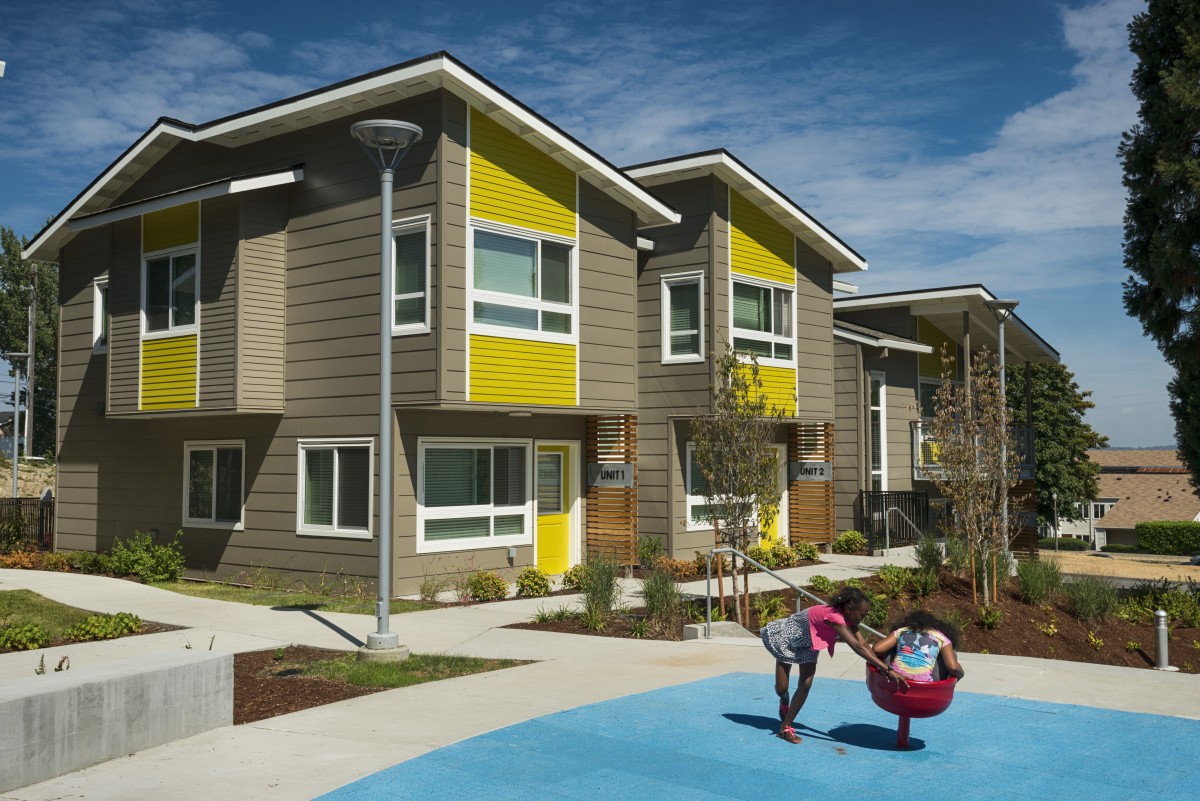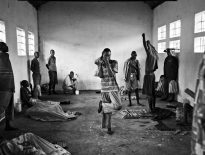Declare: A Nutrition Label for Building Materials
The Declare program, developed by the International Living Future Institute (ILFI) in 2012, is an ingredients initiative for building products that is designed to shape a greener, healthier environment for construction workers, business employees, and customers alike. The Declare program operates through a label given to building products that shows a full list of ingredients, thereby exposing components that potential buyers and employers would not otherwise know were there. While most manufacturers keep their ingredients under wraps under the guise of “trade secrets,” leaving citizens in the dark when it comes to toxins in their homes and working environments, Declare brings those ingredients into the open.
Declare, like all ILFI programs, operates on a basis of transparency. The logic behind a transparency model suggests that providers and customers alike will be happier when no one’s trying to hide toxic chemicals in their paneling, framing, or insulation. Labeling those chemicals where they exist, after all, creates an incentive to remove them altogether and develop safer alternatives. In fact, the Declare label has already borne success in this regard: one company has quickly phased out PVCs in its plumbing products. Declare helps shape a healthier future for all people.
Declare uses the Red List, a catalogue of the world’s most toxic chemicals, in order to classify products. Product don’t necessarily have to be free of Red List ingredients–the immediate goal is transparency. However, if a manufacturer eradicates all Red List compounds from its product, it receives a special designation.
Operating like a nutrition label for the building industry, Declare brings to the fore the inner makeup of materials that surround people every day. In an ever-globalized world, Declare helps shape a transparent materials economy.
We sat down with Andrea Cooper, manager of the Declare program, to peer into the pillars of Declare and glimpse how it operates.
Question: Can you give me a brief purpose/goals statement for Declare?
Andrea Cooper: Declare is a transparency platform to help product specifiers select transparent building products that meet the most stringent health and ecological requirements.
Q: What is the Red List and what does it do?
AC: The Red List is the identification of the 22 worst-in-class chemical families. The Red List includes chemicals, compounds, and elements known to pose serious risks to human health and the greater ecosystem. These chemicals are a common occurrence in the building products industry and we believe that their use can be phased out through healthy substitutions and green chemistry practices.
As it relates to the Living Building Challenge, the Red List serves to guide product manufacturers, specifiers, and purchasers to healthier and ecologically responsible products. The Red List encourages sustainable innovation in the building products industry.
Q: How is Declare integrated within the Living Building Challenge (LBC), the Living Product Challenge (LPC) and the Living Community Challenge (LCC)?
AC: The Declare program was developed to directly support the material selection efforts of Living Building Challenge project teams. Declare labels report product California Department of Public Health (CDPH) compliance in support of the Healthy Interior Environment requirements; ingredients and references to Red List chemicals and applicable exceptions in support of the Red List requirements; Forest Stewardship Council (FSC) content and availability in support of the Responsible Industry requirements, final point of assembly in support of the Appropriate Sourcing requirements; and end-of-life options in support of the Net Positive Waste requirements. Additionally, incorporating Declare labels is a direct requirement of the Living Building Challenge and the growth of the Declare database supports the integration of Declare products into projects.
Involvement in the Declare program is a requirement of the Red List Imperative within the Living Product Challenge, a core Imperative. The Living Product Challenge is a multi-attribute product certification program, which directly supports and furthers the Declare program’s mission of healthy product chemistry, ecological responsibility, and transparency.
Declare products can also be specified in the Living Materials Plan used by Living Community Challenge projects to meet the Red List requirements. Declare can be specified in the project Master Planning documents to encourage health and ecological responsible product selection at both the building and community or campus scale.
Q: How many total Declare labels are issued?
AC: There are over 400 Declare labels from 15 Construction Specifications Institute (CSI) MasterFormat Divisions and 87 manufacturers, representing thousands of unique products.
Q: Can you share an inspiring anecdote about a company that recently applied for a Declare label?
AC: TOTO USA applied for multiple Declare labels for their plumbing fixtures. Inspired by the Living Building Challenge Red List requirements, they re-engineered many of their flush fixture products to remove PVC. PVC components were replaced with Ethylene Propylene Diene Monomer. TOTO USA now has 25 Declare labels, 13 of which have achieved Red List Free of LBC Compliant Declare status. Many manufacturers are following in the footsteps of TOTO and working to evaluate and redesign their products to reduce and eliminate the occurrence of Red List ingredients.
Q: Do you see manufacturers encouraging others in the industry to register Declare labels?
AC: One of the biggest hurdles for many manufacturers interested in Declare is obtaining transparent ingredient lists from their supply chains. We are witnessing many manufacturers successfully advocating within their supply chain to join Declare. There are more coating, binder, and small component manufacturers reaching out about their interest in Declare. This will open up Declare for many new building product manufacturers; they are looking to these transparent component manufacturers to create a more transparent supply chain for their own products.
Q: Are unexpected businesses catching on?
AC: I wouldn’t say there are unexpected businesses catching on, but the rate at which many manufacturers commit to Declare is surprising. It is not uncommon for us to receive a commitment from a manufacturer to submit twenty or more products for Declare (at once).
Manufacturers are taking notice! Much of this growth can be attributed the advocacy work of our Living Building Challenge teams. Many manufacturers are learning about Declare through conversations with project team members. They understand the growing demand for transparent and healthy products. Manufacturers want to actively support the efforts of the most sustainable design and construction projects in the world.
Q: Can you talk about the significance of Declare’s acceptance into LEED v.4?
The Declare program’s acceptance as a documentation method for Option 1 of the LEED v4 Building Product Disclosure and Optimization, Materials Ingredients credit expands the program’s audience and speaks volumes to the importance of the core mission of Declare: Material Health and Transparency. Acknowledgement by the USGBC supports the specification of healthy, transparent products beyond those projects attempting certification under the Living Building Challenge and further rewards those manufacturers who have joined Declare in support of the transparency movement. Acceptance into LEEDv4 also allows project teams attempting both the Living Building Challenge Materials Petal and LEED to streamline their product selection and documentation efforts; those products highlighted in the Declare database now support both certification paths.
Q: How do you read a Declare label?
AC: The top portion of a Declare label features the product name, manufacturer, final point of assembly and end-of-life options. The information in the top portion clearly identifies the product and highlights the relevant information for the Living Building Challenge Living Economy Sourcing and Net Positive Waste Imperatives. The middle portion of the label includes the product ingredients, organized by component. Ingredients on the Red List are highlighted in red text and ingredients on other chemical of concern lists are highlighted in orange. The center of the label also references the applicable product exceptions and their corresponding components. The bottom of the Declare label includes the Declare ID, label expiration date, and Declare status.
Products with a Declare status of Red List Free have been designed without any Red List ingredients and do not rely on any Living Building Challenge exceptions to demonstration compliance. LBC Compliant products meet the written requirements of the Living Building Challenge using one or more published exceptions. Both Red List Free and LBC Compliant labels can be used by Living Building Challenge project teams without any additional research or documentation. Declare status products are fully transparent, but contain one or more Red List ingredients not currently covered by existing program exceptions. Declare status manufacturers have committed to the transparency movement and their products comply with the LEEDv4 documentation.


